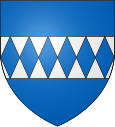Vinassan
| Vinassan | ||
|---|---|---|

|
|
|
| region | Occitania | |
| Department | Aude | |
| Arrondissement | Narbonne | |
| Canton | Les Basses Plaines de l'Aude | |
| Community association | Le Grand Narbonne | |
| Coordinates | 43 ° 12 ' N , 3 ° 4' E | |
| height | 3–142 m | |
| surface | 8.96 km 2 | |
| Residents | 2,646 (January 1, 2017) | |
| Population density | 295 inhabitants / km 2 | |
| Post Code | 11110 | |
| INSEE code | 11441 | |
 Mairie Vinassan |
||
Vinassan is a French commune with a population of 2,646 (1 January 2017) in the Aude department in the region of Occitania . It belongs to the Arrondissement of Narbonne and the community association Le Grand Narbonne, founded in 2002 .
geography
The municipality of Vinassan is located five kilometers northeast of Narbonne and about twelve kilometers from the Mediterranean coast. The part of the municipality of Vinassan east of the A9 autoroute is part of the Regional Nature Park Narbonnaise en Méditerranée . The hamlets of Marmorières and Saint-Félix belong to the municipality .
The municipality extends from the plain between Aude and the large lagoons of Étang de Bages-Sigean and Étang de l'Ayrolle in the west to the heights of the Massif de la Clape (also known as Montagne de la Clape ) in the east. The isolated mountain range, which reaches a maximum height of 214 meters, is only about 150 km² in size and forms the northeasternmost foothills of the Pyrenees .
The municipality of Vinassan borders Salles-d'Aude to the north, Fleury to the northeast, Narbonne to the east and west , Armissan to the south and Coursan to the northwest .
Population development
The location near the sea and the short distance to the city of Narbonne favored a steady increase in population. Due to new building areas north and west of the old village center, the settlement area has almost doubled since the 1980s.
| year | 1962 | 1968 | 1975 | 1982 | 1990 | 1999 | 2007 | 2017 | |
| Residents | 734 | 817 | 878 | 980 | 1427 | 2004 | 2218 | 2646 | |
| Sources: Cassini and INSEE | |||||||||
Attractions
- The former ice cellar, which Cardinal Richelieu still licensed for ten years, is now largely derelict. Back then, the ice cream was fetched by horse and cart from the Montagne Noire, about 50 kilometers away, and sometimes only lasted until early summer.
- The 11th century Romanesque church of Saint-Martin was reconstructed in 1896. It is classified as a historic monument ( Monument historique ).
Economy and Infrastructure
The flat west of the community area is used intensively for agriculture. Here as well as in the hilly northeast of the municipality, viticulture is predominant, the locations of which are part of the small La Clape wine-growing region , located immediately northeast of the Corbières wine-growing region. There are 50 winegrowers and nine farms in the community (growing cereals and vegetables, poultry farming).
The D 32 trunk road from Charmes to Rambervillers runs through the municipality of Essegney . In the nearby town of Charmes there is a connection to the motorway-like RN 57 from Nancy to Épinal . Charmes station, one and a half kilometers from Essegney, is on the Blainville-Damelevières-Lure railway line .
supporting documents
- ↑ Vinassan on cassini.ehess.fr
- ↑ Vinassan on insee.fr
- ↑ La Glacière de Vinassan on vinassan.fr. Retrieved February 19, 2011 (French).
- ^ Entry in the Base Mérimée , a database of the French Ministry of Culture. Retrieved February 19, 2011 (French).
- ↑ Farms and winemakers on annuaire-mairie.fr (French)


